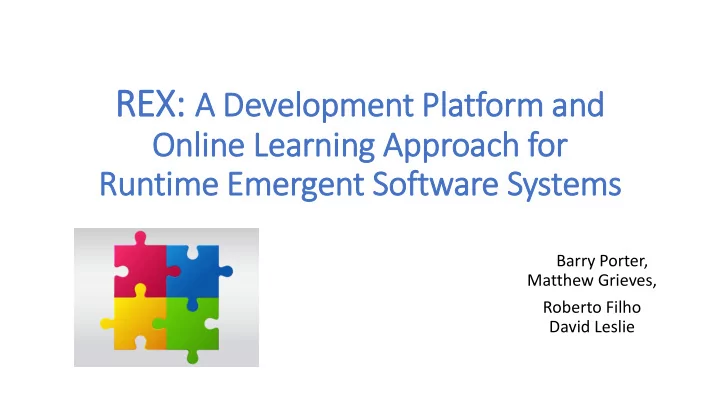

REX: A Development Platform and Online Learning Approach for Runtime Emergent Software Systems Barry Porter, Matthew Grieves, Roberto Filho David Leslie
Introduction Designing, Analyzing and Maintaining – Millions of LOC: Is it sustainable? Software development: Models, Policies, and Processes Autonomous, Self-Adaptive, and Self Organized Software System Emergence of Software System - Autonomously from pool of available building blocks Responsive to actual runtime conditions. Can show rationale behind the choice
REX: Development Platform Implementation Platform- Dana (Dynamic Adaptive Nucleic Architecture) PAL Framework Perceive – Internal + External conditions Assemble and Re-assemble modules Learn Online Learning – Statistical Linear Bandits, using Thompson Sampling.
Dana Component Based Software Paradigm All Components – Runtime Replaceable Multi-threaded imperative language (what and how) Example: From Source code component provides App requires io.Output out{ int App:main(AppParam params[]){ out.println("Hi! :-)") return 0 } }
Dana: Runtime Adaptation
PAL Framework: Perception & Assembly Perception Implemented using Recorder Interface Data – Event and Metrics (Name, Value, Flag) Assembly Starts with main component of target system Read Required components (recursively) Search interfaces in resources directory and their potential implementation Example – Interface (io.File) io (Implementation Directory) Create a list of configurations Use Adaptation protocol to reassemble
Sample Implementation: Webserver Number of components in system = 30 File System, String Parsers, Number of configurations – 2*3*(2+5) = 42 Request Handler – Avg response time HTTPHandler – Events for requested resource & their size
Exploration Vs Exploitation: Upper Confidence Bound Action Selection Greedy – Exploit current knowledge to maximize immediate reward Posterior Sampling- Thompson Sampling Estimate posterior distribution using prior distribution
Multi-armed Bandit Arm – One configuration of webserver Action – choose one config and deploy
Handling Environment Changes Entropy – High => Request for different resources zero => Single resource requested repeatedly Text Volume – Highly Compressible Example – HTML, CSS Files High entropy interval – more than 50% request of high entropy 7 Extra Regression Coefficients Total number of configurations = 42*4 = 168
Results – Runtime Adaptation Webserver is actually paused pauseObject – busy waiting for new function call pause – prevent new objects from being instantiated
Results: Divergent Systems Entropy\Text Low High Low Cache Cache & Compress High Default (Due Cache & to hash compression collision)
Results: 1 test iteration = 10 second (1000 experiments) Large File => Less training samples Small HTML Files with low latency Large HTML Files with low latency
Results: Alternating Request Pattern Left - Constantly forget and re-learn
Thoughts Will the adaptation be computationally expensive as number of components and metrics increase ? – Scalable? Impact on QoS during transition Ease of adding access patterns in model Overhead of providing various implementation for a component Vs Simple Knob Tuning Extra overhead of module loading for a large system
Questions ?
Recommend
More recommend